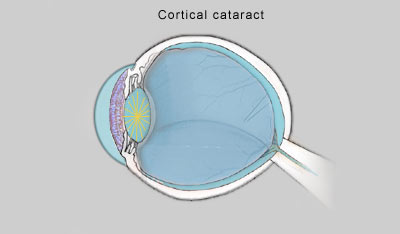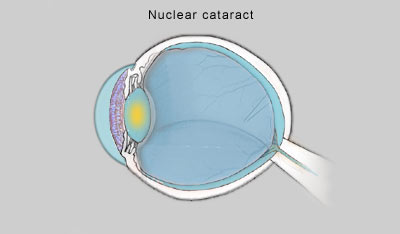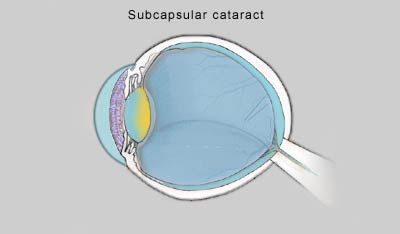Normal Eye Anatomy

A cataract is a clouding of the normally clear lens of your eye. For people who have cataracts, seeing through cloudy lenses is a bit like looking
through a frosty or fogged-up window.
Clouded vision caused by cataracts can make it more difficult to read, drive a car (especially at night) or see the expression on a friend's face.
Most cataracts develop slowly and don't disturb your eyesight early on. But with time, cataracts will eventually interfere with your vision.
At first, stronger lighting and eyeglasses can help you deal with cataracts. But if impaired vision interferes with your usual activities,
you might need cataract surgery. Fortunately, cataract surgery is generally a safe, effective procedure.

The lens, where cataracts form, is positioned behind the colored part of
your eye (iris). The lens focuses light that passes into your eye, producing
clear, sharp images on the retina — the light-sensitive membrane in the
eye that functions like the film in a camera.
As you age, the lenses in your eyes become less flexible, less transparent
and thicker. Age-related and other medical conditions cause tissues within
the lens to break down and clump together, clouding small areas within the
lens.
As the cataract continues to develop, the clouding becomes denser and
involves a bigger part of the lens. A cataract scatters and blocks the light
as it passes through the lens, preventing a sharply defined image from
reaching your retina. As a result, your vision becomes blurred.
Cataracts generally develop in both eyes, but not evenly. The cataract in
one eye may be more advanced than the other, causing a difference in
vision between eyes.


Cortical cataracts are wedge-shaped and form around the edges of the nucleus.

Nuclear cataracts form in the middle of the lens and cause the nucleus, or the center, to become yellow or brown.

Posterior capsular cataracts form faster than the other two types and affect the back of the lens.